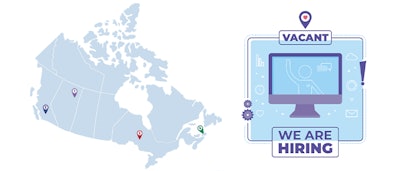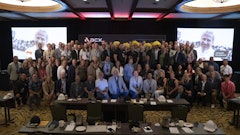
In some parts of Canada, hiring is no longer easy as 1-2-3
Story by BIANCA MATTIOZZI
With the seemingly ever-present skills shortage looming over the industry, Canadian collision centres have been getting creative in attracting new staff to their businesses post-pandemic.
1. ALBERTA
Although Canada’s automotive industry has been having difficulty hiring people, not all hope is lost. With provinces opening more, Fadi Smaidi, the CEO of SkillsTrader, a skilled trade hiring company, says that Ontario and Alberta are better off than the rest of the country when it comes to new talent. “There’s some markets that are more active than others, economies that have reopened earlier have obviously seen a big jump in rehiring, like Ontario for example, who’s just recently opened,” said Smaidi. “The body shops are not as full as they want to be, but the Northern Alberta Institute of Technology (NAIT) has the highest number of enrollments ever. There is clearly more interest in automotive in Alberta.”
SkillsTrader has more technicians looking than there are jobs available, which means that a large part of the reason some shops are struggling to get more talent is because they aren’t advertising enough and letting people know that they are wanting to take apprentices on.
“Not only do they have to let the Universities and the trade schools in their area know that they are open to taking apprentices, but they also have to be better at marketing themselves,” said Smaidi. “So, using social media to promote who they are and what kind of shop that they have will go a long way when it comes to getting apprentices and new hires.”
Carlaw says that for apprentices looking to get into the trade, it is worth going to a place that may pay less in the beginning, if it means they will be trained and develop a higher skillset to make more money later.
“I would say that you should just try to get experience first. If a kid is trying to get into the trade, just get your foot in the door and start in the detail department and show them that you want to be in the trade in the first place,” said Carlaw. “Then pick a shop that you feel is progressive, that can teach you things and is willing to invest time to train you.”
2. BRITISH COLUMBIA
The skills shortage situation is just as dire on Canada’s Pacific coast, according to British Columbian statistics. “I can say that in the last 10-or-so years I’ve been recruiting, I’ve never seen it to be this competitive,” said Wong, a B.C. businessowner. “When we post the job, we’re getting very low response rates,” Wong said. “You know, where pre-COVID, we might see 50 to 60 applicants for one job, (now) we’ll be lucky to see 10.”
Of note, however, is the Pacific coast is the revival of B.C.’s compulsory trades program earlier this year. Cancelled in 2003, the provincial government has re-launched the mandatory skilled trades certification system, which will allow the province to offer more stable and high-paying jobs to skilled trades workers, according to the government.
The certification system will be in phases, and the first phase will start with the 10 jobs that are the most in need of workers, this includes autobody and collision technician, automatic technician, heavy-duty equipment technician, gas-fitter, steamfitter and pipefitter, sheet metal worker, electrician, powerline electrician, industrial electrician, and refrigeration and air conditioning mechanic.
3 . ONTARIO
Corey Carlaw, the owner of CSN Carlaw Collision in Peterborough, Ontario, knows all too well that it’s important to help apprentices as much as possible and give them something to reach for. “We want to put someone on an apprenticeship basically immediately when they get here,” said Carlaw. “There’s a few reasons for that, number one, we’re trying to get people interested in the trade and stay into it in the long run. Then, offering them the opportunity of the apprenticeship gives them a goal to work towards.”
Not only did COVID-19 slow down hiring opportunities, but Carlaw believes that students are now leaning more towards jobs that allow them to work from home, which means the automotive industry is looking less appealing to the newer generations. To top it all off, Carlaw says that the long, and arduous process to get into the trade is turning potential automotive workers away.
“It’s difficult to get into the automotive industry because people have to really want it to go through the long process to get a job. It’s not easy, and it’s not accessible for people,” said Carlaw.
4 . PRINCE EDWARD ISLAND
At CSN Koughan Auto Body on Prince Edward Island, Sam Koughan says they’ve gotten quite creative to reach the youth to inspire a career path in the rewarding collision repair trade. “On Prince Edward Island it’s awful trying to get apprentices. We’re taking kids from high school through a work program, and then we try if we can invest in them through training and try to get them into the trade that way,” he said.
Koughan said one of the reasons there are less and less people getting into the trade simply comes down to people not being educated and informed about the automotive industry and all the opportunities it can bring.
“It comes down to just the lack of awareness. A lot of high school kids don’t even realize that this can be an option as a career,” said Koughan.
























